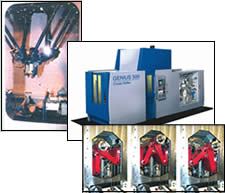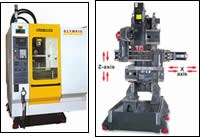Different Directions In Machining Center Motion
Some machining centers have begun to appear that use resultant motion in less elaborate ways. That is, these machines use the resultant motion of different elements moving in different directions to achieve the motion along X, Y or Z, but they do so within machining center designs that are considerably more like standard machines.
Share



Takumi USA
Featured Content
View More





Hwacheon Machinery America, Inc.
Featured Content
View More
Autodesk, Inc.
Featured Content
View MoreThe traditional machining center has axis motors that push in one direction or the other along X, Y and Z. In the 1990s, all of us who attend machine tool trade shows learned that this wasn’t the only way to design the machine. A variety of builders brought out "hexapod" and/or "parallel kinematic" machines in which a daddy-longlegs arrangement of linear-motion members used CNC interpolation to achieve precisely the same X-Y-Z motion as a standard machine.
These novel machining centers make for attention-grabbing live demonstrations at trade shows. In fact, these eye-catching machines began to appear at trade shows not long after the use of attractive female models at these shows began to decline—almost as if some different means of capturing attendees’ attention had to be invented. However, real-life users of these machines remain uncommon to say the least. While a machine tool buyer may notice a trade show booth because of the complex motion of one these machines, that buyer is still more likely to spend money on a machine that has a more standard design.
But now, an important development may go unnoticed beneath the presence of these more elaborate machines. Some machining centers have begun to appear that use the same fundamental idea—resultant motion—in a less elaborate way. That is, these machines use the resultant motion of different elements moving in different directions to achieve the motion along X, Y or Z, but they do so within machining center designs that are considerably more like standard machines.
Here are just two examples. One is the line of "relative motion" machining centers from Olympic Seiki (represented in the United States by Vigor Machinery Company). With these machines, it is not the tool motion or table motion alone that provides the machine’s traverse; it’s the tool and table together. In the X and Z axes, the ballscrew simultaneously moves both table and tool in opposite directions. The feed rate of the tool relative to the part is the sum of the traverse rates of both elements. Ditto for the acceleration. On smaller machines in this line, the resultant acceleration is 2G. In addition to speed, another benefit may be stability. With mated elements moving in symmetry, says the company, the design of this machine favors dynamic balance.
Another machine design taking advantage of resultant motion is the "Genius 500" horizontal machining center from Cross Hüller. On this machine, the X-axis motion—that is, the side-to-side motion—comes from elements that move up and down along the Y direction. The mechanism for this is an inverted V-shaped coupler that carries the spindle. This inverted V straddles between two sets of linear motors that run up and down. When the linear motors move together at the same speed, the result is pure Y-axis motion. But when the linear motors move differently, the difference causes the coupler to pivot, providing the motion in X.
As a result, there is no need for a motor to push along the X axis on this machine. Therein lies a benefit of the design. Whether the motion is X or Y, the force of the axis motors goes along the direction of gravity, where the machine is well-supported (by the floor). Thus the machine can move the tool rapidly throughout the X-Y plane, with none of the motion of the axis motors directly producing sideways forces.
Related Content
Where Micro-Laser Machining Is the Focus
A company that was once a consulting firm has become a successful micro-laser machine shop producing complex parts and features that most traditional CNC shops cannot machine.
Read MoreHow to Determine the Currently Active Work Offset Number
Determining the currently active work offset number is practical when the program zero point is changing between workpieces in a production run.
Read MoreQuick-Change Tool Heads Reduce Setup on Swiss-Type Turning Centers
This new quick-change tooling system enables shops to get more production from their Swiss turning centers through reduced tool setup time and matches the performance of a solid tool.
Read MoreOrthopedic Event Discusses Manufacturing Strategies
At the seminar, representatives from multiple companies discussed strategies for making orthopedic devices accurately and efficiently.
Read MoreRead Next
Building Out a Foundation for Student Machinists
Autodesk and Haas have teamed up to produce an introductory course for students that covers the basics of CAD, CAM and CNC while providing them with a portfolio part.
Read More5 Rules of Thumb for Buying CNC Machine Tools
Use these tips to carefully plan your machine tool purchases and to avoid regretting your decision later.
Read MoreRegistration Now Open for the Precision Machining Technology Show (PMTS) 2025
The precision machining industry’s premier event returns to Cleveland, OH, April 1-3.
Read More





































.jpg;maxWidth=300;quality=90)











